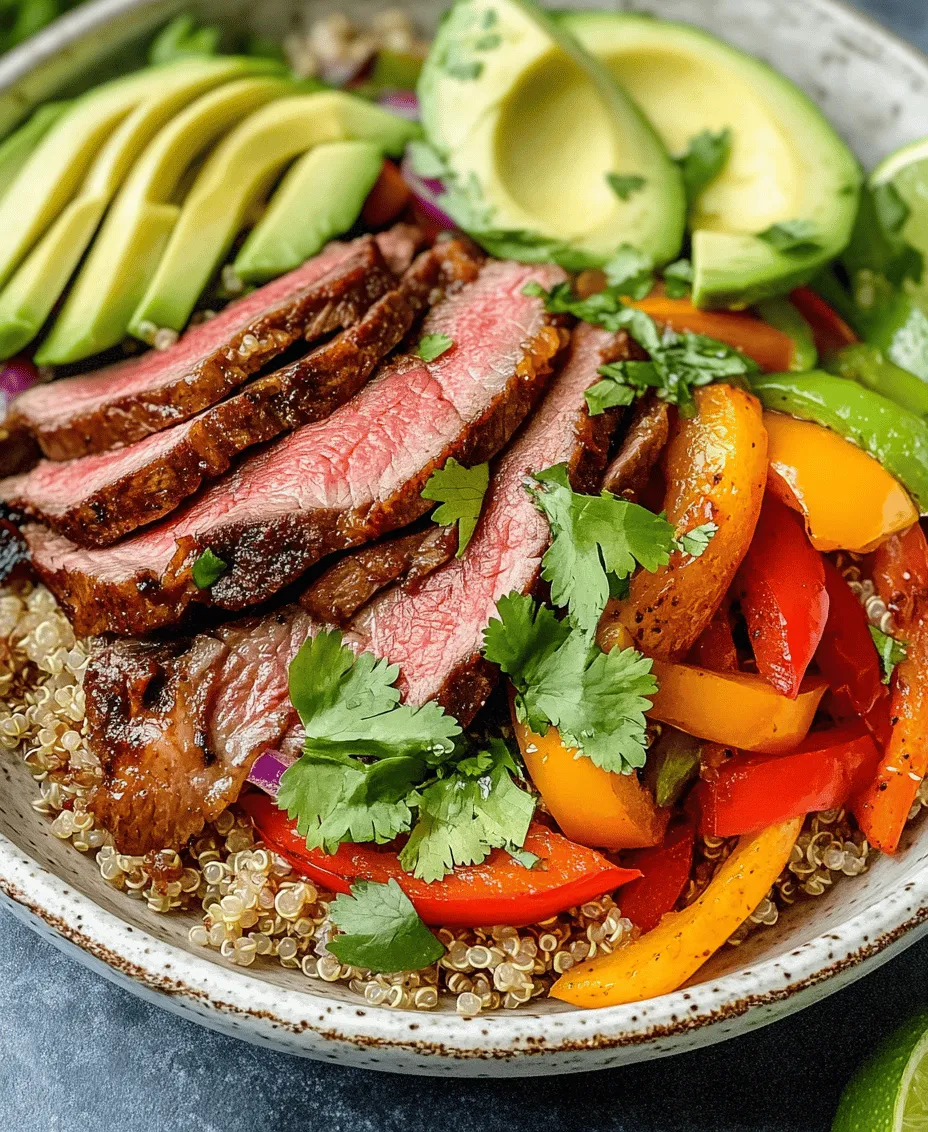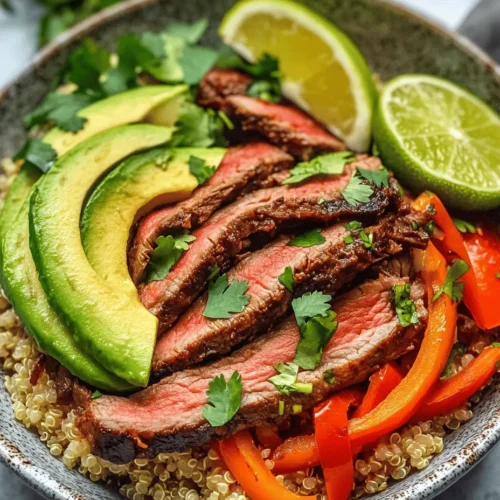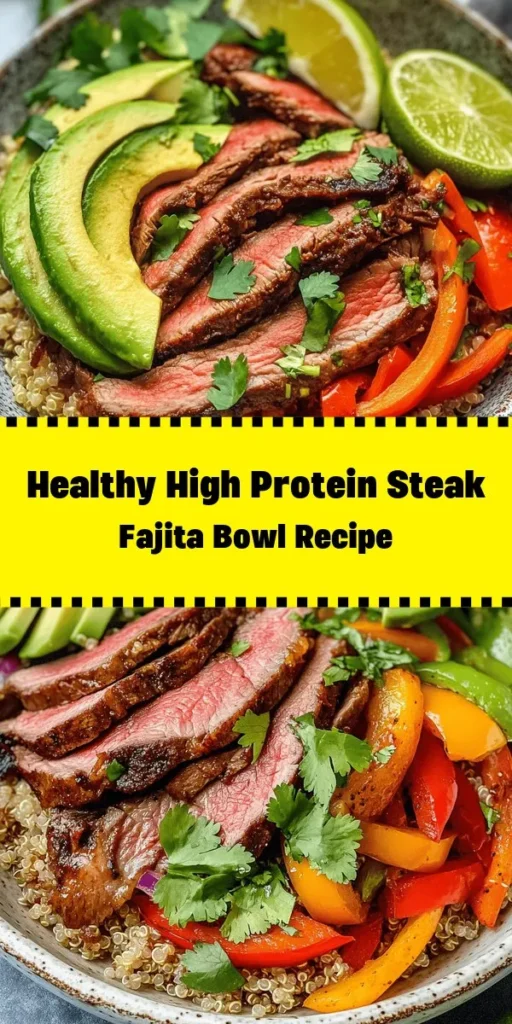Introduction
Steak fajita bowls have surged in popularity over the years, emerging as a go-to dish for those seeking a satisfying, flavorful meal that’s also nutritious. The beauty of a steak fajita bowl lies in its versatility; it can be tailored to fit a variety of dietary preferences and is perfect for anyone looking to incorporate more protein into their diet. Packed with vibrant colors, bold flavors, and an array of textures, this bowl is not just a feast for the stomach but also for the eyes.
High-protein meals are essential for maintaining a balanced diet, especially for those looking to build muscle, lose weight, or simply fuel their active lifestyles. The protein from steak, combined with nutrient-dense vegetables and hearty grains, makes this dish a powerhouse of nutrition. In this article, you will learn how to create a delicious high-protein steak fajita bowl from scratch, including its cultural origins, the nutritional benefits of each ingredient, and step-by-step instructions for perfecting the recipe.
The Allure of Steak Fajita Bowls
Fajitas have their roots in Tex-Mex cuisine, historically originating from the ranches of South Texas. Traditionally, the term “fajita” referred to the cut of meat used, typically skirt steak, which was grilled and served with tortillas and various toppings. Over the years, the concept of fajitas has evolved, and today, they are often served in bowls, allowing for a more substantial and customizable meal.
The combination of flavors in steak fajita bowls is nothing short of spectacular. The smokiness of grilled steak pairs beautifully with the spiciness of peppers and the freshness of toppings like avocado and salsa. This harmonious mix not only tantalizes the taste buds but also provides a sensory experience that makes every bite enjoyable. For health-conscious individuals, steak fajita bowls have become a staple for meal prep due to their convenience and nutritional value, allowing you to prepare a week’s worth of lunches in one go.
Understanding the Ingredients
A high-protein steak fajita bowl is as much about the ingredients as it is about the cooking technique. Each component plays a pivotal role in delivering flavor and nutrition, ensuring that your meal is not only delicious but also beneficial for your health.
Flank Steak
At the heart of any steak fajita bowl is the flank steak. This cut is known for its robust flavor and lean texture, making it an excellent source of protein. Flank steak is rich in essential amino acids, iron, and zinc, which are vital for muscle repair and overall health. When preparing flank steak, it’s crucial to marinate it for at least 30 minutes to infuse flavor and tenderize the meat. Cooking it quickly over high heat will ensure that it remains juicy and flavorful.
Olive Oil
Olive oil is a staple in many kitchens, and for good reason. Not only does it enhance the flavors of your dish, but it also provides healthy fats that are beneficial for heart health. Rich in monounsaturated fats and antioxidants, olive oil can help reduce inflammation and lower cholesterol levels. If you’re looking for alternatives, avocado oil or coconut oil can also be used, each offering unique flavors and health benefits.
Spices
The right spices can elevate your steak fajita bowl from ordinary to extraordinary. Key spices include smoked paprika, cumin, garlic powder, and chili powder. Smoked paprika adds a depth of flavor reminiscent of grilled food, while cumin brings earthiness to the dish. Garlic powder enhances the overall taste, and chili powder introduces a subtle heat that balances the other flavors. A well-seasoned steak is the cornerstone of a great fajita bowl.
Vegetables
Bell peppers and onions are essential components of steak fajitas. These vegetables not only add color and crunch but also pack a nutritional punch. Bell peppers are high in vitamin C, which boosts the immune system and helps with iron absorption. Onions offer anti-inflammatory properties and are a good source of antioxidants. Sautéing these vegetables until they are slightly caramelized enhances their natural sweetness, making them a delicious complement to the savory steak.
Quinoa vs. Brown Rice
When it comes to the base of your fajita bowl, you have the option of using quinoa or brown rice. Quinoa is a nutrient-dense grain that is high in protein and fiber, making it a great choice for those looking to boost their protein intake. It’s also gluten-free and contains all nine essential amino acids, making it a complete protein. On the other hand, brown rice is a whole grain that provides carbohydrates for energy, along with essential minerals like magnesium and selenium. Both options are healthy, so choose according to your dietary preferences.
Black Beans
Black beans are a nutritional powerhouse and a fantastic source of plant-based protein and fiber. They complement the flavors of steak beautifully and add a creamy texture to your fajita bowl. Rich in antioxidants, black beans support heart health and digestion. Incorporating black beans into your bowl not only enhances its protein content but also provides a satisfying and filling component.
Avocado
No fajita bowl is complete without avocado. This creamy fruit is rich in healthy fats, vitamins, and minerals. Avocado contributes a buttery texture that balances out the spices and acidity of the other ingredients. It’s a great source of potassium, which helps regulate blood pressure, and its high fiber content aids digestion. Plus, avocados are delicious, making them a perfect topping for your steak fajita bowl.
Optional Toppings
One of the best aspects of steak fajita bowls is the ability to customize them to your liking. Optional toppings like salsa, cheese, sour cream, or fresh cilantro can elevate your dish and add extra layers of flavor. Consider incorporating a dollop of Greek yogurt as a healthier alternative to sour cream, or add fresh lime juice to brighten the flavors.
Step-by-Step Instructions for the Perfect Fajita Bowl
Marinating the Steak
The first step to creating a flavorful high-protein steak fajita bowl is marinating the steak. Marinating not only infuses the meat with flavor but also helps to tenderize it, making it more enjoyable to eat. Here’s how to do it:
1. Choose Your Marinade: A simple marinade can be made with olive oil, lime juice, minced garlic, smoked paprika, cumin, and chili powder. This combination will enhance the natural flavor of the steak while also adding a zesty kick.
2. Marinate for Flavor: Place the flank steak in a resealable plastic bag or a shallow dish and pour the marinade over it. Ensure the steak is well-coated. For optimal flavor, marinate the steak for at least 30 minutes, but if you have more time, letting it sit for up to 2 hours in the refrigerator will yield even better results.
3. Preheat the Grill or Skillet: While the steak is marinating, preheat your grill or skillet over medium-high heat. A hot cooking surface is crucial for achieving that perfect sear.
4. Cook the Steak: Once the grill or skillet is hot, remove the steak from the marinade and let any excess liquid drip off. Cook the steak for about 4-5 minutes on each side for medium-rare, adjusting the time depending on your desired doneness. Use a meat thermometer to check for doneness; 130°F (54°C) is ideal for medium-rare.
5. Rest and Slice: After cooking, let the steak rest for about 5 minutes to allow the juices to redistribute. Then, slice the steak against the grain into thin strips. This will ensure maximum tenderness and flavor in each bite.
By following these steps, you’ll have a flavorful, marinated steak ready to be the star of your high-protein fajita bowl. The next part of this article will delve into the preparation of the vegetables, the choice of grains, and the assembly of your delicious steak fajita bowl. Stay tuned for the complete recipe experience!

Cooking the Vegetables: Techniques for Achieving the Perfect Sauté
To create a High Protein Steak Fajita Bowl, the vegetables play a crucial role in both flavor and texture. Achieving the perfect sauté is key to enhancing their natural sweetness while maintaining a slight crunch that complements the tender steak. Here are some techniques to ensure your vegetables are sautéed to perfection:
1. Choose the Right Pan: A wide, heavy-bottomed skillet or a cast-iron pan is ideal for sautéing vegetables. This allows for even heat distribution and prevents steam from building up, which can lead to soggy veggies.
2. Preheat the Pan: Before adding any oil or vegetables, make sure your pan is preheated over medium-high heat. This step is essential as it helps to quickly sear the vegetables, locking in their flavor.
3. Use the Right Oil: Opt for oils with high smoke points, such as avocado oil or grapeseed oil. These oils can endure higher temperatures without burning, allowing for better caramelization.
4. Don’t Overcrowd the Pan: When sautéing, it’s crucial not to overcrowd the pan. If the pan is too full, the vegetables will steam rather than sauté. Sauté in batches if necessary to ensure even cooking.
5. Stir Occasionally: Allow the vegetables to sit undisturbed for a minute or two to develop a nice char, then stir occasionally to ensure even cooking. This technique will help to achieve that delightful contrast between slightly charred outsides and tender insides.
Searing the Steak: Tips for Achieving Ideal Doneness and Texture
Searing the steak properly is paramount to achieving a flavorful and juicy component for your fajita bowl. Here are some tips to help you get the perfect sear:
1. Choose the Right Cut: Flank steak, skirt steak, or sirloin are excellent choices for fajitas. They are flavorful cuts that cook quickly and become tender when sliced against the grain.
2. Bring to Room Temperature: Before cooking, let the steak sit at room temperature for about 30 minutes. This helps it cook more evenly.
3. Season Generously: Use a generous amount of salt and pepper, and consider adding spices like cumin or chili powder for an extra flavor boost. This not only enhances the taste but also creates a beautiful crust during searing.
4. Sear in High Heat: Heat your pan until it’s hot. Add a small amount of oil and wait for it to shimmer before placing the steak in the pan. Sear for about 3-4 minutes on each side for medium-rare, adjusting the time according to your desired doneness.
5. Let it Rest: After cooking, let the steak rest for 5-10 minutes. This allows the juices to redistribute, resulting in a more flavorful bite.
Assembling the Bowl: Layering for Balanced Flavor and Nutrition
Once your vegetables are sautéed and your steak is perfectly cooked, it’s time to assemble your High Protein Steak Fajita Bowl. The way you layer the ingredients can significantly affect the overall taste and nutrient profile.
1. Base Layer: Start with a base of whole grains or greens. Brown rice, quinoa, or even mixed greens provide a nutritious foundation.
2. Protein Layer: Slice the steak against the grain to ensure tenderness and layer it over the base. This allows the juices to seep into the grains or greens below.
3. Vegetable Layer: Add a generous portion of your sautéed vegetables, including bell peppers and onions. The colorful mix not only looks appealing but also adds fiber and vitamins.
4. Beans for Additional Protein: Consider adding black beans or pinto beans for an extra protein boost and creaminess. They complement the flavors well and provide additional nutrients.
Adding Toppings: Enhancing Flavor with Fresh Ingredients
Toppings can elevate your High Protein Steak Fajita Bowl, adding freshness and complexity to each bite. Here are some suggestions for delicious toppings:
1. Fresh Herbs: Cilantro and parsley can brighten the dish and add freshness. Chop finely and sprinkle generously over the top.
2. Avocado or Guacamole: Creamy avocado or a dollop of guacamole adds richness and healthy fats, balancing the spices in the bowl.
3. Sour Cream or Greek Yogurt: A spoonful of sour cream or Greek yogurt adds creaminess and tang, making it a delightful contrast to the spiced steak.
4. Salsa: Fresh salsa or pico de gallo can add a burst of flavor. Choose from mild to spicy varieties based on your preference.
5. Lime Wedges: A squeeze of fresh lime juice can enhance the flavors and add brightness to the overall dish.
Nutritional Breakdown of the High Protein Steak Fajita Bowl
Understanding the nutritional content of your High Protein Steak Fajita Bowl can help you appreciate its benefits. Here’s a breakdown of its nutritional profile:
Total Protein Content and Its Importance in a Balanced Diet
A single serving of the High Protein Steak Fajita Bowl can provide approximately 30-35 grams of protein, depending on the amount of steak and beans used. Protein is essential for muscle repair, immune function, and overall health. It helps to keep you full longer, making it a crucial component of a balanced diet.
Caloric Value and Macronutrient Composition
The caloric value of this bowl typically ranges around 500-600 calories per serving. The macronutrient composition can be broken down roughly as follows:
– Protein: 30-35g
– Carbohydrates: 50-60g (primarily from grains and vegetables)
– Fats: 15-20g (from healthy sources like avocado and oils)
Health Benefits of Each Ingredient in the Bowl
– Steak: Provides high-quality protein and essential amino acids.
– Bell Peppers: Rich in vitamins A and C, they support immune health and skin health.
– Onions: Contain antioxidants and compounds that can help reduce inflammation.
– Beans: Offer plant-based protein, fiber, and important minerals.
– Whole Grains: Provide complex carbohydrates and fiber for sustained energy.
Customizing Your Steak Fajita Bowl
One of the best aspects of the High Protein Steak Fajita Bowl is its versatility. Here are some ideas for customizing your bowl to suit different tastes and dietary preferences:
Suggestions for Alternative Proteins: Chicken, Tofu, or Shrimp
If you’re looking to switch up the protein, consider using grilled chicken breast, shrimp, or marinated tofu. Each offers different flavors and textures while still providing a high protein content.
Vegetarian and Vegan Adaptations for the Recipe
For a vegetarian version, substitute steak with black beans or roasted portobello mushrooms. For a vegan adaptation, use tofu or tempeh and ensure that any toppings, like sour cream, are plant-based.
Seasonal Vegetable Variations to Keep the Dish Fresh and Vibrant
Incorporate seasonal vegetables such as zucchini, corn, or cherry tomatoes to keep the dish fresh and exciting. These add different textures and flavors while maintaining nutritional value.
Spicing It Up: Adjusting Heat Levels for Different Palates
Adjust the heat level by using different types of peppers or adding hot sauce or chili flakes. For those who prefer milder flavors, omit spicy ingredients or use sweet bell peppers.
Meal Prep and Storage Tips
Preparing meals in advance can save time and ensure you have healthy options available. Here’s how to efficiently meal prep your High Protein Steak Fajita Bowl:
How to Prepare the Bowl in Advance for Busy Weeknights
Cook the steak and sauté the vegetables ahead of time. Store them separately in airtight containers in the refrigerator. When you’re ready to eat, simply reheat the components and assemble your bowl.
Best Practices for Storing Leftovers to Maintain Freshness
Store leftover components in separate containers to prevent sogginess. Steaks can be kept in the refrigerator for up to 3-4 days, while sautéed vegetables can last about 2-3 days.
Reheating Guidelines for Optimal Taste and Texture
Reheat the steak and vegetables in a skillet over medium heat to maintain their quality. If using a microwave, do so in short intervals to avoid overcooking.
Conclusion
Making a High Protein Steak Fajita Bowl at home not only allows you to control the ingredients but also ensures that you enjoy a nutritious and satisfying meal. With its rich flavors, vibrant colors, and customizable options, this bowl is perfect for any weekday dinner or meal prep. Experiment with different proteins, vegetables, and toppings to create your perfect dish. By prioritizing balanced meals, you are not just fueling your body but also embracing a healthier lifestyle. So gather your ingredients, follow these steps, and enjoy the deliciousness of a homemade steak fajita bowl.



